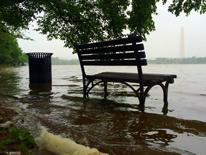
The District is already experiencing the impacts of human-made climate change. Climate change refers to long-term changes in global temperature, precipitation, wind patterns, and other aspects of climate. These global changes have serious consequences for the District. In the past few years, the District has seen record-breaking extreme weather (like heat waves and snowstorms), higher tides caused by rising sea level, heavy rains, flooding, and warmer temperature averages. The District Government is approaching climate change from two sides: adaptation and mitigation.
Climate Adaptation
Adaptation means preparing District residents, neighborhoods, buildings and infrastructure for the impacts of climate change, including extreme heat, increased precipitation, more dangerous storms and sea level rise. Learn more about how the District is preparing for the impacts of climate change.
Climate Mitigation
Mitigation refers to reducing emissions from the following greenhouse gases (GHGs) that intensify climate change—carbon dioxide, methane, and nitrous oxide.
- DOEE has received a Climate Pollution Reduction Grant (CPRG) for climate action planning from the U.S. Environmental Protection Agency (EPA). Learn more >>
- The District is committed to becoming carbon neutral and climate resilient by 2045, and achieving neutrality in its own operations by 2040. The Climate Commitment Act of 2022 codified the District’s interim climate targets and a new interagency taskforce will work to deliver a roadmap to 2040.
- Climate Commitment Interagency Taskforce Meeting – August 28, 2025
- Agenda, Meeting Minutes
- Climate Commitment Interagency Taskforce Meeting - April 23, 2025
- Agenda , Meeting Minutes
- Climate Commitment Interagency Taskforce Meeting - January 13, 2025
- Agenda, Meeting Minutes, Slides
- Climate Commitment Interagency Taskforce Meeting – July 16, 2024
- Agenda, Meeting Minutes, Slides
- Climate Commitment Interagency Taskforce Lauch – May 1, 2024
- Agenda, Meeting Minutes, Slides
- Climate Commitment Interagency Taskforce Meeting – August 28, 2025
- In December 2023, DOEE released Carbon Free DC, the District’s strategy to reach carbon neutrality by 2045. Rooted in community priorities for improving health, affordability, accessibility, and economic opportunity, Carbon Free DC identifies key actions necessary to cut greenhouse gas emissions to achieve the District’s 2045 commitment to an equitable and carbon free future.
Carbon Free DC is the next step in the District’s leadership on equitable climate action. To reach carbon neutrality, the District must transform the drivers of emissions across all sectors—buildings, energy, transportation, and waste— focusing on ways to reduce wasted energy and use more clean, renewable power, while building a more resilient and livable city for all residents.
The District has already made tremendous progress toward carbon neutrality, cutting emissions by 36% between 2006-2021. However, that still leaves more than 7 million metric tons of carbon emissions per year that the District needs to eliminate to achieve carbon neutrality by 2045.
Each of Carbon Free DC’s goals include measurable milestones and targets, including when certain strategies must be implemented to reduce emissions. Check out the Summary, Policy Roadmap, and Story Map to learn more:
- Carbon Free DC Summary
- Carbon Free DC Policy Roadmap
- Carbon Free DC Story Map
- Carbon Neutrality FAQ
- The District’s Clean Energy DC plan is the roadmap to achieve the Sustainable DC goal of reducing GHGs by 60% by 2030.
- Progress on reducing emissions is measured by an annual inventory of the city’s GHGs. The District has cut citywide GHG emissions since 2006, but there is much work ahead to achieve our short- and long-term climate targets.
- Tackling existing building energy use is a key priority for the District, as more than 70% of citywide emissions come from the energy needed to operate our homes and buildings. The Building Energy Performance Standard (BEPS) Program was set forth in Title III of the Clean Energy DC Omnibus Act of 2018. The BEPS was created to help reduce GHG emissions and energy consumption by 60% by 2030, through increased energy efficiency of existing buildings.
- The District is taking its first actions to assess and reduce the carbon embodied in the goods, services, and activities on which the city runs. The Green Food Purchasing Amendment Act set a target to cut emissions from District Government food and beverage purchases 25% by 2030. Learn more about other sectors for which the District is looking to address consumption-based emissions.
Commission on Climate Change and Resiliency
The District of Columbia Commission on Climate Change and Resiliency (DC-CCCR), established in 2016, provides an independent perspective on the District’s actions to reduce greenhouse gas emissions and adapt to a changing climate. Composed of 16 experts, the DC-CCCR reviews the District’s plans, policies, and programs and recommends priorities to City Council and the Mayor’s Office. The DC-CCCR is driven by equitable and meaningful solutions that will serve residents, protect critical infrastructure, and advance economies.
- The DC-CCCR released its first report in 2019
- The DC-CCCR released its second report in 2022

